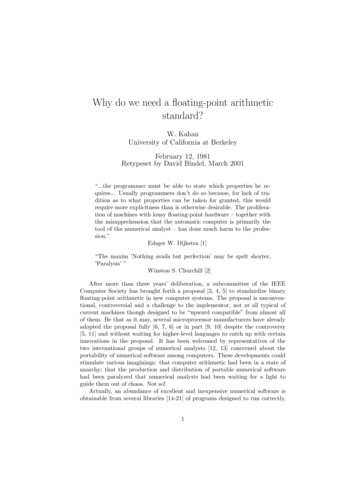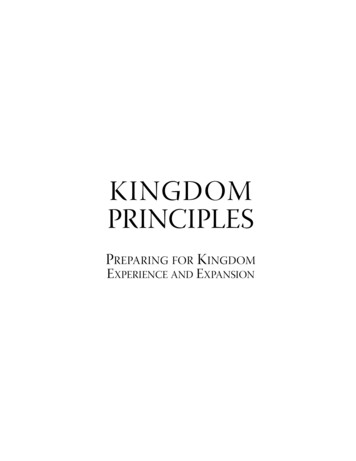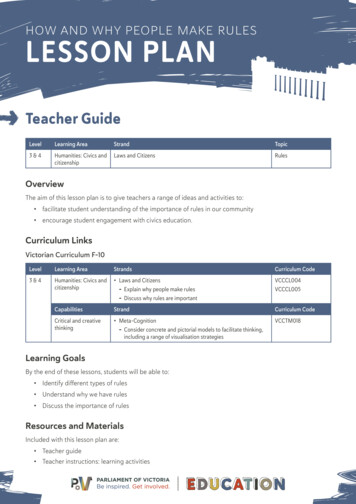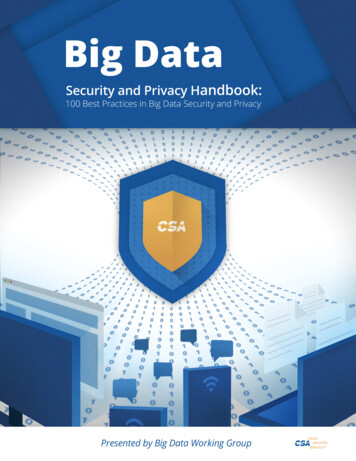
Transcription
Why do we need a floating-point arithmeticstandard?W. KahanUniversity of California at BerkeleyFebruary 12, 1981Retypeset by David Bindel, March 2001“.the programmer must be able to state which properties he requires. Usually programmers don’t do so because, for lack of tradition as to what properties can be taken for granted, this wouldrequire more explicitness than is otherwise desirable. The proliferation of machines with lousy floating-point hardware – together withthe misapprehension that the automatic computer is primarily thetool of the numerical analyst – has done much harm to the profession.”Edsger W. Dijkstra [1]“The maxim ’Nothing avails but perfection’ may be spelt shorter,’Paralysis’ ”Winston S. Churchill [2]After more than three years’ deliberation, a subcommittee of the IEEEComputer Society has brought forth a proposal [3, 4, 5] to standardize binaryfloating-point arithmetic in new computer systems. The proposal is unconventional, controversial and a challenge to the implementor, not at all typical ofcurrent machines though designed to be “upward compatible” from almost allof them. Be that as it may, several microprocessor manufacturers have alreadyadopted the proposal fully [6, 7, 6] or in part [9, 10] despite the controversy[5, 11] and without waiting for higher-level languages to catch up with certaininnovations in the proposal. It has been welcomed by representatives of thetwo international groups of numerical analysts [12, 13] concerned about theportability of numerical software among computers. These developments couldstimulate various imaginings: that computer arithmetic had been in a state ofanarchy; that the production and distribution of portable numerical softwarehad been paralyzed that numerical analysts had been waiting for a light toguide them out of chaos. Not so!Actually, an abundance of excellent and inexpensive numerical software isobtainable from several libraries [14-21] of programs designed to run correctly,1
albeit suboptimally, on almost all major mainframe computers and several minis. In these libraries many a program has been subjected to, and has survived,extensive tests and error-analyses that take into account the arithmetic idiosyncrasies of each computer to which the program has been calibrated, therebyattesting that no idiosyncrasy defies all understanding. But the cumulativeeffect of those idiosyncrasies and the programming contortions they induce imposes a numbing intellectual burden upon the software industry. To appraisehow much that burden costs us we have to add it up, which is what this papertries to do.This paper is a travelogue about the computing industry’s arithmetic vagaries. Instead of looking at customs and superstitions among primitive tribes,we shall look at arbitrary and unpredictable constraints imposed upon programmers and their clients. The constraints are those associated with arithmeticsemantics rather than syntax, imposed by arithmetic hardware rather than byhigher-level languages. This is not to say that the vagaries of higher- level language design, of compiler implementation, and of operating system conventionsare ignorable, even if sometimes they can be circumvented by assembly languageprogramming. Language issues are vital, but our itinerary goes beyond them.Numerical software production is costly. We cannot afford it unless programming costs are distributed over a large market; this means most programs mustbe portable over diverse machines. To think about and write portable programswe need an abstract model of their computational environment. Faithful modelsdo exist, but they reveal that environment to be too diverse, forcing portableprogrammers to bloat even the simplest concrete tasks into abstract monsters.We need something simple or, if not so simple, not so capriciously complex.1Rational One-liners.Why are continued fractions used far less often than their speed and sometimesaccuracy seem to deserve? One reason can be gleaned from the exampleR(z) : 7 3/(z 2 1/(z 7 10/(z 2 2/(z 3))))which behaves well (3.7 R(z) 11.8) for all z and can be computed fairlyaccurately and fast from the foregoing “one-line” definition provided certainconventions like(nonzero)/0 , (finite) , (finite)/ 0,have been built into the computer’s arithmetic, as has been done to some machines. But on most machines attempts to calculateR(1) 10, R(2) 7, R(3) 4.6, R(4) 5.5stumble after division by zero, which must then be avoided if the program is tobe portable over those machines too. Another algebraically equivalent one-line2
definitionR(z) : ((((7z 101)z 540)z 1204)z 958)/((((z 14)z 72)z 151)z 112)avoids division by zero but falls afoul of exponent overflow when z is hugeenough, no bigger than 3 109 on some machines; moreover, this second expression for R(z) costs more arithmetic operations than the continued fraction andis less accurate. In general, no way is known to avert spurious over/underflow,division by zero or loss of accuracy, without encumbering expressions with testsand branches that result in portable but inscrutable programs.2Tests and Branches.What makes tests and branches expensive is that programmers must decidein advance where and what to test; they must anticipate every undesirablecondition in order to avoid it, even if that condition cannot arise on any but afew of the machines over which the program is to be portable. Consequently,programmers generally are obliged to know that on some widely used computersa statement likeif z 6 0 then s : 3 sin(z)/z else s : 2will, when executed with certain very tiny values z, stop the machine and allegethat division by zero was attempted. These machines treat all sufficiently tinynonzero numbers z as if they were zero during multiplication and division, butnot during addition and subtraction; consequently these machines calculatez/0.004 z 250. 0 and 0.004/z (division by zero)whereas(z z)/0.008 (z z) 125. 6 0 and 0.002/1(z z) (a finite number).To be portable over these machines the statement above must be changed toif 1 z 6 0 then s : 3 sin(z)/z else s : 2or betterif 1 z 6 1 then s : 3 sin(z)/z else s : 2The last test opens another can of worms.Some compilers try to be helpful by using extra precision to calculate subexpressions during the evaluation of arithmetic expressions. This is a good ideaprovided the programmer knows that it is being done. Otherwise conundrumscan be created by statements likep : q rx : y zif x 6 y z then print “why not?”if p 6 q r then print “how come?”3
which print nothing on some systems, print “why not? how come?” when q rand y z are evaluated to more precision than can be stored in p and x, and printjust “how come?” when the compiler’s optimizer notices that the subexpression(z 6 y z) involves a value x that has just been calculated in an extra-wideregister and need not be reloaded from memory. Consequently subexpressionslike (y z 6 y) may remain true even when z is so tiny that y z and y wouldbe equal were they rounded to the same precision.3Precision and Range.The accuracy of floating-point arithmetic operations is worse than about 6 significant decimals on some machines, better than 33 on others. Some machinesserve more than one level of precision, some as many as four. One machine’ssingle-precision format can be almost as accurate as another machine’s double.If he does not know how precise “SINGLE PRECISION” really is, the wouldbe portable programmer faces dilemmas. An algorithm that is faster than anyother to achieve modest accuracy may be incapable of achieving high accuracy.An algorithm that works superbly if executed in arithmetic substantially moreaccurate than the given data and desired solution may fail ignominiously if thearithmetic is only slightly wider than the data and solution. An algorithm thatuses some double-precision arithmetic to support successfully a computationperformed mainly in single-precision may collapse if “DOUBLE PRECISION”is actually less than twice as wide as “SINGLE PRECISION”, as happens onseveral machines. Therefore a library of portable programs may have to copewith a specific task by including just one program that is grossly suboptimalon almost every machine, or else by including several similar programs of whicheach user must reject all but the one that suits his own machine. Neither choiceis a happy one for the people who assemble and maintain the library.A similar dilemma is posed by various machines’ over/underflow thresholds.The overflow threshold Λ is the largest number, the underflow threshold λ isthe smallest positive normalized number that can be represented by a machine’sfloating-point arithmetic. The diversity of thresholds is sampled in Table 1.Worse than that diversity is the unpredictability of reactions to over/underflow;many machines trap or stop, most set underflows to zero, some overflow to Λ,some overflow to , a few overflow to zero, and so on.No wonder then that simple tasks spawn hordes of complex programs; hereis one example, the calculation of the root-sum-squares norm of a vector V,pRtsmsq(n, V ) : (V12 V22 . . . Vn2 )The obvious program is a simple one:sum : 0; forp i 1 to n do sum : sum V [i]**2Rtsmsq : (sum)This simple program is the best on machines with ample range and precision,but on most machines this program encounters at least one of the followinghazards:4
MachineDEC PDP-11, VAX,F and D formatsUnderflow λ2 128 2.9 10 39Overflow Λ21 27 1.7 103 8DEC PDP-10;Honeywell 600, 6000;Univac 110x single;IBM 709X, 704X2 129 1.5 10 3921 27 1.7 103 8Burroughs 6X00 single8 51 8.8 10 47876 4.3 1068H-P 30002 256 8.6 10 782256 1.2 1077IBM 360, 370; Amdahl1;DG Eclipse M/600; .16 65 5.4 10 791663 7.2 107510 9910100CDC 6X00, 7X00, Cyber2 976 1.5 10 29421070 1.3 10322DEC VAX G format;UNIVAC, 110X double2 1024 5.6 10 30921023 9 10307HP 8510 49910500Cray I 2 8192 9.2 10 2467 28192 1.1 102466DEC VAX H format2 16384 8.4 10 4933216383 5.9 104931Burroughs 6X00double8 32755 1.9 10 29581832780 1.9 1029603Most handheldcalculatorsProposed IEEE Standard: INTEL i8087; Motorola 6839single2 126 1.2 10 382127 1.7 1038double2 1022 2.2 10 30821023 9 10307 2 16382 3.4 10 4932 216383 5.9 104931double-extendedTable 1: Floating-Point Over/Underflow Thresholds5
i) When n is huge (106 ) but the precision is short (6 significant decimals) then sum, and hence Rtsmsq, may be badly obscured by roundoff amounting to almost n/2 units in its last place.ii) Even though Rtsmsq’s value should be unexceptional, sum mayover/underflow (e.g. if some V [i] Λ or all V [i] λ).The simplest way to subdue both perils is to evaluate the sum of squaresusing extra precision and range as may be achieved in a few computing environments via a declaration likeDouble Precision sum.The proposed IEEE floating-point arithmetic standard allows implementors, attheir option, to offer users just such a capability under the name “ExtendedFormat”. But most computing environments afford no such luxury, and insteadoblige programmers to circumvent the hazards by trickery. The obvious wayto circumvent hazard 2 is to scan V to find its biggest element Vmax and thenevaluatepPn2Rtsmsq : Vmax 1 (V [i]/Vmax ) )but this trick violates all but the third of the following constraints upon thecalculation:I) Avoid scanning the array V , more than once because, in some “virtual memory” environments, access to V [i] may cost more time thana multiplication.II) Avoid extraneous multiplications, divisions or square roots becausethey may be slow. For the same reason, do not request extra precision nor range.III) Avert overflow; it may stop the machine.IV) Avert underflow; it may stop the machine.The only published program that conforms to all four constraints is due toJ. L. Blue [22]. Other published programs ignore constraint IV and assumeunderflows will be flushed to zero. One such program is C.L. Lawson’s SNRM2in LINPACK[17], called norm by W.S. Brown[23]. Another program, VECTOR NORM by Cox and Hammarting [24], violates constraint II. All theseprograms succumb to the first hazard (i) above, so there is need for yet anotherprogram; it will be furnished in Figure 7. Only this last program can be generalized conveniently to cope with sums of products as well as sums of squares,and then only by violating constraint III, as will be shown in Figure 8. Noneof the programs is transparent to the casual reader. None is satisfactory forvectorized machines.Suppose an ostensibly portable program works correctly for all physicallymeaningful data when run on one of the machines with a wide range listed below6
the middle of Table 1. But the program is not robust in the face of intermediateover/underflow, so it produces wrong answers and/or warning messages and/orstops when run with meaningful but unusual data on a machine with a narrowrange. Who is to blame? We, who supply machines and programs, tend toexculpate ourselves and blame instead whoever used that program to treat thatdata on that machine; he should have spent more money to buy a machinewith far wider range than encompasses his data and output, or he should havepaid more money for a better and robust but more elaborate program, or heshould not worry about unusual data beyond the normally ample capacity ofwhat we have recently sold to him. Is this issue really just a question of costvs. capability? No. From time to time a simple program, run on a system withnarrow range and precision but designed felicitously, will deliver better resultsand sooner than an elaborate program run on a system with wider range andprecision. Thus the competency of its design, its intellectual economy and manyother parameters of a system must figure significantly enough in its performanceto deserve our consideration too.4RadixAlmost every machine that provides floating-point arithmetic does so in binary(radix 2), octal (8), decimal (10) or hexadecimal (16). Biological and historicalaccidents make 10 the preferred radix for machines whose arithmetic will beexposed to frequent scrutiny by humans. Otherwise binary is best. Rad- icesbigger than 2 may offer a mininuscule speed advantage during normalizationbecause the leading few significant bits can sometimes remain zeros, but thisadvantage is more than offset by penalties in the range/precision tradeoff [25]and by “wobbling precision” [19, p.7]. For instance, the proposed IEEE standardsqueezes as much range and worst-case precision from a 32-bit binary formatas would demand 34 bits in hexadecimal. For the programmer whose task is toproduceas accurate a program as possiblethe technical hindrance arises less from not enjoying the use of the optimal radixthan from not knowing which radix his program will encounter.Consider for example two algebraically equivalent expressionsq1 (z) : 1/(1 z); q2 (z) : 1 z/(1 z)Which one can be calculated more accurately? If z , is big then q1 (z) is betterbecause q2 (z) suffers from cancellation. If —z— is tiny then q1 (z) is worsebecause its error can be bigger than q2 (z)’s by a factor almost as large as theradix, and this is serious if the radix is 16 and the precision short. To minimizethat error a conscientious programmer might writeif 0 z t(B) then q(z) : 1 z/(1 z) else q(z) : 1/(1 z)7
where t(B) is a threshold whose optimal value depends deviously upon theradix B and upon whether arithmetic is rounded or chopped. Specifically, whenarithmetic is rounded after normalization the optimal values aret(2) 1/3, t(8) 0.728, t(10) 0.763, t(16) 0.827but when arithmetic is chopped after normalization the optimal values are different. And when arithmetic is rounded or chopped before normalization, differentthresholds and a rather different program are called for:if 0 z t(B) then q(z) : (0.5 z/(1 z)) 0.5else q(z) : 1/(0.5 (z 0.5)).The reason for using 0.5 0.5 in place of 1 will become clear later.5End EffectsSome computers can do funny things. Each of the following phenomena ispossible for a wide range of operands on some machine which is or was widelyused:y z 6 z y; z 6 1 z 6 0; z y but z t 6 y t; 1/3 6 9/27.These phenomena are caused by peculiar ways of performing roundoff. Furtheranomalies are caused by peculiar ways of handling exponent over/underftowwithout stopping the machine and sometimes without any indication visible tothe program or its user:((y z)/y)/z 0.00001y 1 z 0 but y/z 0((y z)/y)/z 100000.y/z 0.99 but y z 0.a 0, b 0, c 0, d 0, z 0, but(a z b)/(c z d)(a b/z)/(c d/z) 1.5. caused by underflow to 0.causedcausedcausedcausedbybybybyoverflow to Λ;overflow to 0;underflow to λ;underflow to 0;Other paradoxes were discussed above under Tests and Branches. Somefurther anomalies cannot be blamed upon computer architects. For instance,discrepancies can arise whenever decimal-binalry conversion is performed differently by the compiler than by the run-time Input/Output utilities:Input z . the user types 9.999 to signal end-of-data.if z 9.999 then print result else continue processing data;. but no result ever gets printed.These funny things computers do can cause confusion. Some of the confusioncan be alleviated by education, whereby we come to accept and cope with thoseanomalies that are inescapable consequences of the finiteness of our machines.8
But education cannot mitigate the demoralizing effects of anomalies when theyare unnecessary or inexplicable, when they vary capriciously from machine tomachine, when they occur without leaving any warning indication, or when nopractical way exists to avert them.The end effect of caprice is a perverse indoctrination. After a while programmers learn to distrust techniques which formerly worked perfectly and provablyon their old computer system but now fail mysteriously on the new and bettersystem. By declaring those techniques to be “tricks”, as if they never deservedto work, we reverse the traditional educational paradigm:“A trick used three times is a standard technique.”(Attributed to G. Polya.)6Models.I know about several attempts to impose some kind of intellectual order uponthe arithmetic jungle. An early attempt by van Wijngaarden [26] failed partlybecause it was excessively abstract and complicated (32 axioms) and partly because a few very widely used computers did not conform to his model. LatelyW.S. Brown [23, 27, 28] has contrived another model. It is an outstandingaccomplishment, simultaneously simpler and more realistic than every previous attempt, easily the best available description of floating-point arithmeticfor programs that must be portable over all machines within reason. By aptassignment of possibly pessimistic values for a few parameters including radix,precision and over/underflow thresholds pertinent to an artfully designated subset of the computer’s floating-point number system, Brown’s model encompassesnot only“. computers of mathematically reasonable design, but can alsoencompass a variety of anomalies. While a thorough study of realworld floating-point anomalies may lead one to despair, the situationcan be summarized rather neatly, and with little exaggeration, bystating that any behavior permitted by the axioms of the model is actually exhibited by at least one commercially important computer.”[23, pp. 11-12]Conversely, every anomaly enumerated in previous paragraphs, except possibly unannounced overflow to zero, is subsumable within a model like Brown’s.All these models, new and old, share the notion of a fuzzy floating-point variablewhose fuzziness, though unknowable, cannot exceed a known tolerance.The proposed IEEE standard is quite different. Rather than describe abstractly some long list of minimal properties that an arithmetic engine musthonor, the proposal prescribes in detail how an arithmetic engine shall be designed, whence follow the minimal properties and many more. The engine’sdesigner is allowed only a limited amount of leeway in the optional features,mostly related to capacity, that he may choose to implement; the designer may9
choose to support only the single-precision format (32 bits wide), or to supporttwo formats, or possibly three, and to charge different prices accordingly. Eachformat has its designated subset of the real numbers represented as floatingpoint numbers; the single-precision format has one sign bit, an eight-bit exponent field, and a 23-bit field for the significand’s fraction, allowing for onemore “implicit bit” to make up 24 bits of precision. Each format has its ownover/underflow thresholds (cf. Table 1) and special bit-patterns reserved for and NaN s; more will be said later about N aN N ot-a-N umber. Alsoto be discussed later are the obligatory responses prescribed by the standardfor every exception (Invalid Operation, Division by Zero, Over/Underflow andInexact Result); for now we note that the designer can supplement but notsupplant those responses, so programmers can predict for every exception whatresponse will occur unless a program has explicitly requested something else.The designer may choose how much of the proposal to implement in hardware,how much in firmware (microcode in read-only memory), how much in software, thereby trading off speed against cost. The proposal says nothing aboutthe relative speeds of, say, multiplication vs. division. But the designer cannot perform roundoff arbitrarily; his design must conform to the following rulesunless a program asks explicitly for something else: Every algebraic operation ( , , , /, ) upon one or two operands mustdeliver its result to a destination, either implicit in an arithmetic expressionor designated explicitly by a program’s assignment statement; the destination’sformat cannot be narrower than either operand’s format.The result delivered must be the closest in the destination formatto the exact value that would have been calculated were range andprecision unbounded; and if the exact value lies just midway betweentwo adjacent numbers representable in the destination’s format thenthe one whose least significant digit is even shall be the result.The only exceptions to this rule are the obvious ones - Invalid Operationslike 0/0 with no exact value, and Overflow to which occurs only when therounded value would otherwise be bigger than the overflow threshold Λ.These rules are comparatively simple as arithmetic rules go, and permit aprogrammer to infer from his chosen format(s) exactly how the arithmetic engine will behave. Most of the inferences are as pleasant as anyone accustomedto computation might desire. Some of the inferences associated with underfloware slightly surprising to programmers accustomed to having underflows go tozero; that is contrary to the rules set out above. Therefore the proposal includesa Warning Mode designed to defend those programmers against arithmetic ambush; it will be discussed later.The difference between the proposed IEEE standard and the aforementionedmodels boils down to this: Having selected a format with its concomitant width,radix (2), precision and range, a programmer knows exactly what results mustbe produced by arithmetic engines that conform to the standard, whereas anengine that merely conforms to one of those models is capable of excessivearithmetic diversity. Programming for the standard is like programming for one10
of a small family of well-known machines, whereas programming for a modelis like programming for a horde of obscure and ill-understood machines all atonce.7Program Libraries’ Costs and Penalties.In the absence of a prescriptive standard like the IEEE proposal, two stra- tegiesare available to the would-be architect of a great library of numerical software.One strategy is to .Customize: Calibrate a version of the library to the arithmetic idiosyncrasiesof each computer upon which the library is intended to be supported.This is the strategy chosen most often for the elementary transcendental functions like exp, cos, . and for some similarly heavily used higher transcendentalfunctions like erf. It could lead to almost as many different libraries as thereare different styles of arithmetic, though the situation is not yet that bad.A second strategy is to strive for universal .Portability: Impose upon programmers a discipline whereby all their programs exploit only those arithmetic properties supported by some universal model encompassing all styles of arithmetic within reason; when thediscipline succeeds the programs are provably portable to all machineswithin reason.This strategy has succeeded for many matrix calculations and, when environmental parameters [29, 30] pertaining to radix, precision and range are accessibleto the program, for iterative equation-solving, quadrature, and much more. Butthe parameters are not always easy to interpret unambiguously [31, 32]; see thesection after next. Neither need a program’s reliability and effectiveness be easyto prove from the model’s abstract axioms. Suppose a programmer seeks butcannot find such a proof; the logical next step is to scrutinize his program tofind a bug and fix it. After exhaustive tests reveal no bug, the programmer maysuspect that only because he is unskilled in the model’s style of inference washe unable to find a proof. What should he do next? Should be encumber hisprogram with unnecessary defenses against imaginary threats? Suppose he canprove by test as well as theory that his program works flawlessly on his ownmachine, with which he has become thoroughly familiar; has he the right tohope that his program will not fail except on some hypothetical machine that,while conforming to the model, does so only perversely? This question will bere-examined a few paragraphs below.The architects of the great numerical subroutine libraries [14-21] deserveour admiration for their perseverance in the face of arithmetic anomalies whichappear to be accumulating insurmountably, though each is by itself a minorirritant. To contain costs, the architects have pursued the second strategy,portability, whenever possible, even if occasionally a proliferation of ostensiblyportable programs had to be tolerated in order to accommodate irreconcilable11
differences among arithmetic engines. The results have been surprisingly good,all things considered. But these triumphs of intellect over inscrutability arePyhrric victories won at the cost of too many man-years of misdirected ingenuity; had the libraries not been subsidized by government [33] nor by occasionally inadvertent corporate munificence, none of us could afford to use them.As befits an era of diminished expectations, the libraries’ performance has intentionally been compromised; some programs accept an unexpectedly limitedrange of data, some programs are less accurate than they could be, some morecomplicated to use than they should be, some less helpful than we would likewhen things go wrong, and some are slow. We shall see in detail why theseperformance penalties cannot be avoided entirely if programs must be portableover machines with unnecessarily widely disparate arithmetic engines. Suchpenalties, or the belief that they exist, tend to undermine the perceived utilityof the libraries and stimulate an urge to replace a portable program by anothermade-to-order and, presumably, more nearly optimal for a specific machine.Moreover, programmers have egos that will not be denied self-expression. Ironically, many a made-to-order program has turned out worse than the libraryprogram it was to supplant. Let us not blame sub-optimal decisions about suboptimal programs upon sub-optimal programmers when the culprit is actuallya programming environment so sub-optimal as to defy education and repel tidyminds. Let us look at that environment.8Models of Paranoia.No realistic conclusion about the programming environment for portable numerical software can be drawn without some experience of the way simple tasksturn into quagmires. Here is an example of a simple task:Write two fast, accurate and portable programs to calculatesin θ(t) qgiven t tan(θ/2), and alsoΨ(t) arcsin(1)2 arccos(0.25 0.75 sin3 θ(t))2The reader may escape the quagmire by skipping over several pages to Diminished Expectations but the programmer assigned a task like this mustwade through the following muck.The diligent programmer soon discovers thatsin θ(t) sin(2 arctan t) 2/(t 1/t) 2t/(1 t2 ),and the last two expressions cost much less time to evaluate than sin(2 arctan(t))provided 1/t or t2 does not overflow. However sin θ 1 whereas both 2/(t 1/t) and 2(t/(1 t2 )) might conceivably exceed 1 by a rounding error whenevaluated for t slightly less than 1 on some (unknown) machine. Therefore theformula used for sin θ when t is near 1 must (for the sake of portability to thatunknown machine) be transformed into, say,sin θ(t) t/( t ( t 1)2 /2),12
Real function sin2arctan(t) : real t ;if t 2 then return 2/(t 1/t)else return t/( t 0.5 ( t 1)**2)end sin2arctan;Real functionppsi(t) : real t ;return (arcsin(1)**2 arccos((1 3 sin2arctan(t)**3)/4)**2)end psi.Figure Afrom which sin θ 1 follows immediately because universally y z implies y/z 1despite roundoff. Keeping sin θ 1 avoids misadventure during subsequentcalculation ofarccos(0.25 0.75(sin θ)3 )by constraining the arccosine’s argument to lie always between -0.5 and 1 inclusive despite roundoff. These precautions are justified because without them thearccosine expression above could be invalid on some machines; it flashes lightson the T.I. SR-52, 58, 58C and 59 when they calculate sin θ 1.000000000004at θ 89.99995 degrees or θ 1.5707954541 radians.The arccosine’s argument
portability of numerical software among computers. These developments could stimulate various imaginings: that computer arithmetic had been in a state of anarchy; that the production and distribution of portable numerical software had been paralyzed that numerical analysts had been waiting for a light to guide them out of chaos. Not so!

![[Page 1 – front cover] [Show cover CLEAN GET- AWAY 978-1 .](/img/13/9781984892973-6648.jpg)









